As much as I enjoy working Tonka in a ring (click on the dressage category to the right to read posts about that), I believe in balancing that schooling with time on the trail. Not only is it good cross-training, but it makes both of us happy. Even when there’s snow on the ground, we walk in the woods.
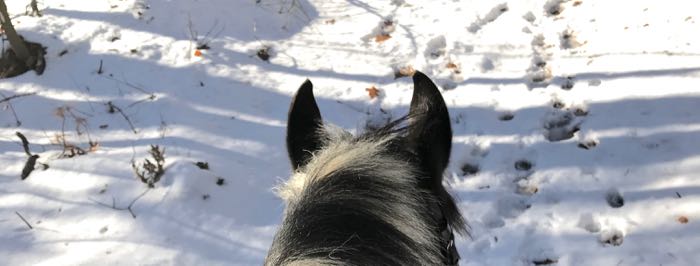
But all too often, between November and April, winter weather keeps us indoors. Sometimes the snow isn’t deep, but the footing is too dangerous. Although what you see in this photograph is beautiful, the horses are standing on slippery ice. Even with studs on their shoes, it’s not safe on the trails.
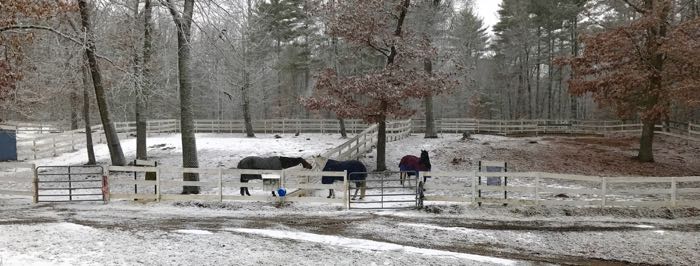
This is why I appreciate being able to board at a barn with an indoor arena. But that has it’s own winter dangers – snow on the roof, which slides off with a loud crack, a sudden shadow past the skylights, and a boom as it hits the ground.
A horse can go from being this relaxed,
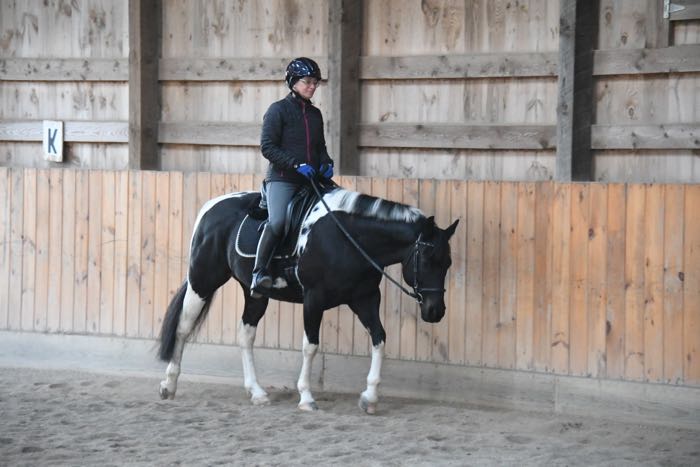
To this: (I don’t have a photo of a Tonka bolting under saddle, but this gives you an idea of what he’s capable of when excited.)

Some riders, prudently, don’t ride when snow is sheeting off of the roof. Tonka is not what’s called a spooky horse, but I’ve gotten off of him when it sounds like we’re inside of an avalanche. However, for anything less than that, I’ve taught him to be calm.
Because of how I train, Tonka understands cause and effect. Unlike some other modes of training, it’s not do this or get punished, it’s offer a behavior and get rewarded. He’s allowed to look at things, react (in a safe way) and check in with me for my opinion. This makes Tonka a thinking horse. The first time that we were in the arena and the snow flew off of the roof with a thud, he rightly reacted with fear. I got off and led him outside. He looked at the snow on the ground. He looked at the roof. He saw the snow slide.
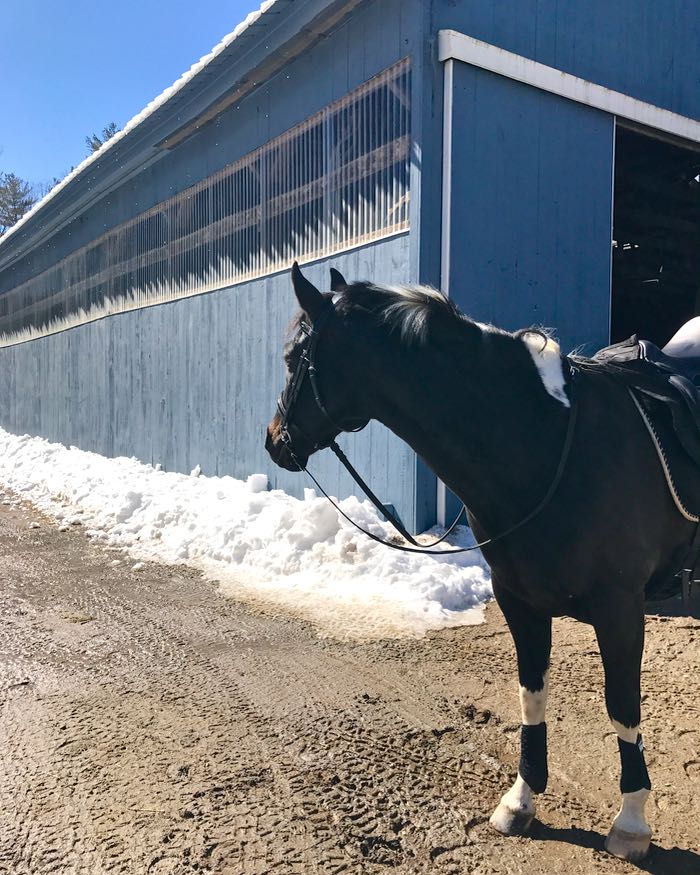
He got that what was making that noise was not a danger to him.
Of course the sound of snow hitting the ground is startling and we both jump. But because Tonka understands what the noise is, we can get on with our ride. The other day though, instead of snow, it was something new – icicles. These chimed as they shattered. That was different! All of a sudden Tonka felt about a foot taller and he vibrated with tension. Once again we went outside to look at the cause of the noise. Oh, that’s nothing, said Tonka, and we went back in.
To reduce the fear factor even more, I’ve made the sound of snow falling into a predictor of something good. When the snow thuds, Tonka gets a cookie.
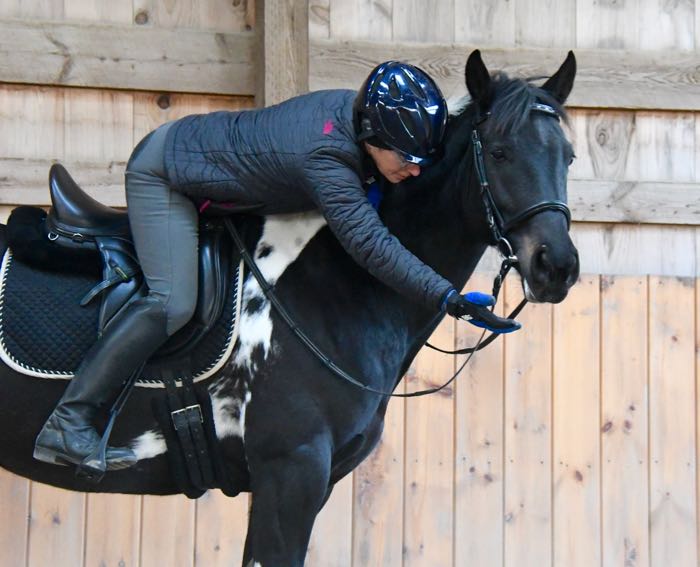
So now when he hears the snow thump down, he tenses for a moment (so do I, one can’t help oneself) and then he focuses on me. Hey, do I get something yummy now?
I’ve used this same technique with deer in the woods. Spotting a deer means that he can stop and get a mint. He likes deer.
What frightens your horse? Have you trained him to see it as a good thing?


Excellent post. Love the idea of showing the horse what made the noise; Tonka obviously took a good look-and-listen at the fallen snow and icicles, and then went Oh. Nothing.
Reminds me of my poodle’s terror of statues and busts of humans. If I touched the statue, and let him smell my hand to smell that the horrifying object is made of plaster or metal or stone he relaxed–as long as HE didn’t have to actually touch it himself.
When I first got Lily Dog, she had an aversion for men with beards, especially if they were smokers. I should have used your technique, although the men might have thought me rude 🙂
Such a lovely post. I love how you are able to show Tonker and keep up the flow of good communication and trust.
That flow comes from my respect for my horse’s intelligence and good intent. When I hear “respect” bandied about in terms that really means subservience, I get frustrated and sad. Thanks for letting me know that my writing communicated the difference.
Thank you so much for sharing your knowledge and tips. I have been struggling with how to say “Yes” more often than “No” and this post has helped me think about my approaches and responses in a much more positive way. Grateful.
Your comment made my morning! It’s not the training details that change the world to a kinder place – it’s the perspective. We’re brought up on “no” and changing to “yes” takes conscious effort. Good for you to be on that path! Thank you for the coffee. I’m drinking a cup now while I plan out future blogposts. Your support means a lot (and keeps me powered by caffeine.)
I have the same thing with the snow and ice on the barn roof and also on our house. The horses are pretty well used to it, although we didn’t really have any this year so I don’t know about the new horses.
One of my horses is spooked by logs and dead trees laying along side of the trails. I’ve let her stop and take her time to go past them, then let her sniff them, but then there will be one with the light shining on it a ways up the trail, and by time we get there of course the light isn’t shining on it so she doesn’t pay any attention to it. She may pass up most of them then one doesn’t look right to her I guess.
If you want to see a spooked horse, just wait until it gets a whiff of a big cat. I’ve only had one encounter like that as there aren’t many around here, but I don’t care to do it again.
There are some things you can’t train for. I’d say the whiff of a mountain lion is one of them. You can try, with your log-spooky horse, to teach him that boldly walking by gets a reward. So, I’d reduce the sniffing and looking to a glance, (which is perfectly fine), give him a reassuring word that you know that log is okay, and then ask him to march on boldly. That marching gets the praise and hoopla (and mints). Reward as he is marching, mid-step so that he knows it’s the calm forward movement that is what you want.
Thanks Terry, giving her a mint when she is marching by the dreaded log sounds like a good idea, She usually stops before she gets to the log, on high alert, and so this seems like a solution. I will certainly do this, and when she just sort of glances at one and keeps on walking by probably a mint would be good at that time also.
If I’m riding my horse and she smells a big cat nearby I will be very happy if she spooks, spins and runs! My job will be simply to stay on board!
I’m happy that I don’t live in big cat country!
So simple, and so effective!
Luckily my horse has a stall in the indoor so he is used to the different noises. The thing that scares him is when the big doors at the ends of the indoor are partially open. He is sure something is going to come through the opening, and I’ve no doubt that something like that has happened in his past. He is fine if they are wide open or totally closed. I usually start at the opposite end of the doors and gradually work our way closer. Then we practice walking out the opening and spending time in the woods behind the indoor.
That makes sense. He can’t get a good look at whatever is passing by, so he can’t assess whether it’s dangerous or not. I’d be curious if he’s always afraid of the doors partially open, or if only on sunny days. Horses don’t see well in glare, and it takes their eyes longer to adjust to changes from light to dark.
He is on alert on both sunny and overcast days, but you have an interesting point.
Bailey has been practicing being brave indoors through the winter as well! She has learned that snow crashing from the roof is a good thing. She now turns her head to look back at me after it happens looking for her reward for being brave. She is learning to love being relaxed and will often turn to look at me for a treat for reassurance if she hears or sees something new. We stop and wait it out, slowly eating treats, until the tension is gone. We have developed a language! Thanks, Terry!
Lisa, I’ve been thinking about you and Bailey! We’ll have to schedule another training session this spring.
Other readers please note: Lisa and Bailey work with me. She lives in the Springfield, MA area. If anyone else out that way wants to schedule an in-person training session, let’s talk. You could split my travel fee, which would greatly reduce the cost of my visit.
I’d love to try this but my mare gets too pushy about treats in the arena. A scratch and kind words work well for her. I love that you show Tonka the source of the noise.
Some horses get anxious and pushy with food. They’ll do the behaviors, but it comes with other problems. I worked with a horse with an extreme case of that. I wrote about it here. Also, it’s the perspective or rewarding what you want – food is usually the easiest reinforcement, but there are others. I’ve written about that here. Let me know how your training goes!